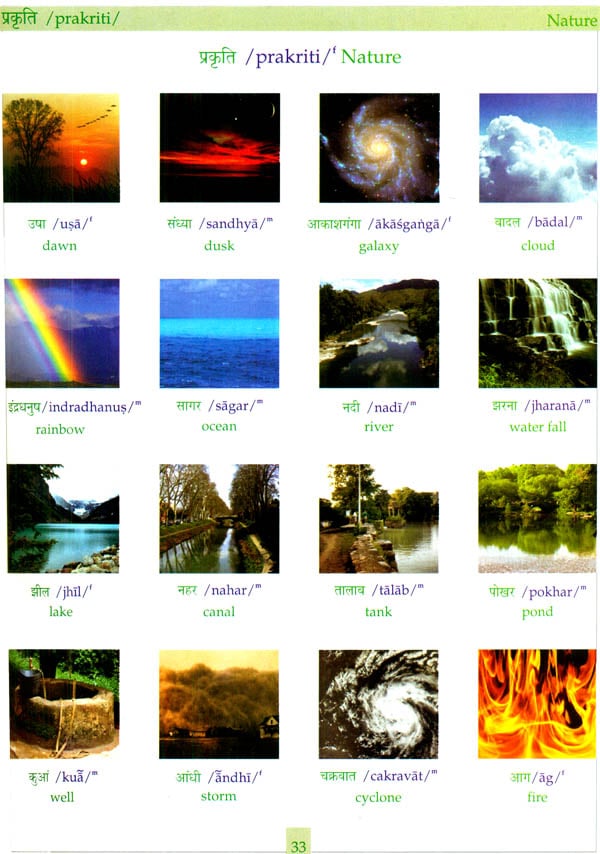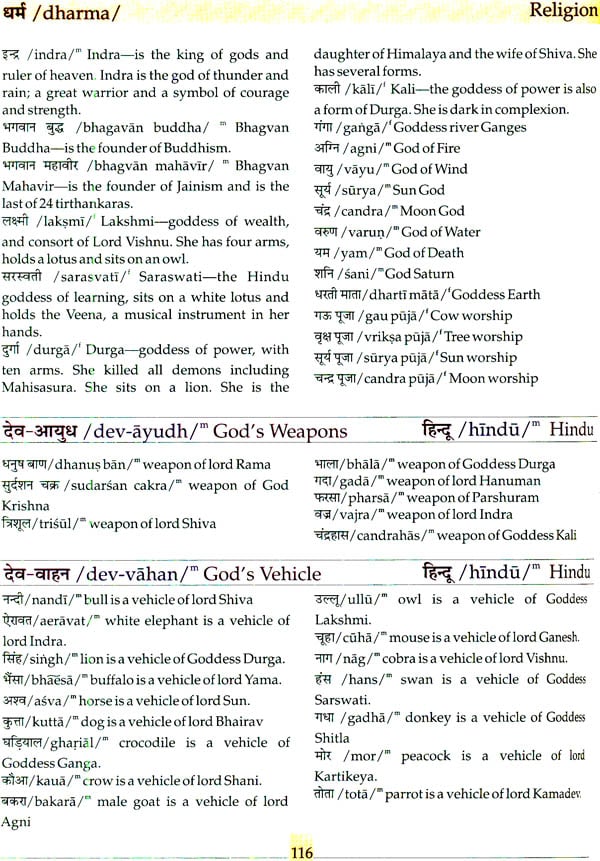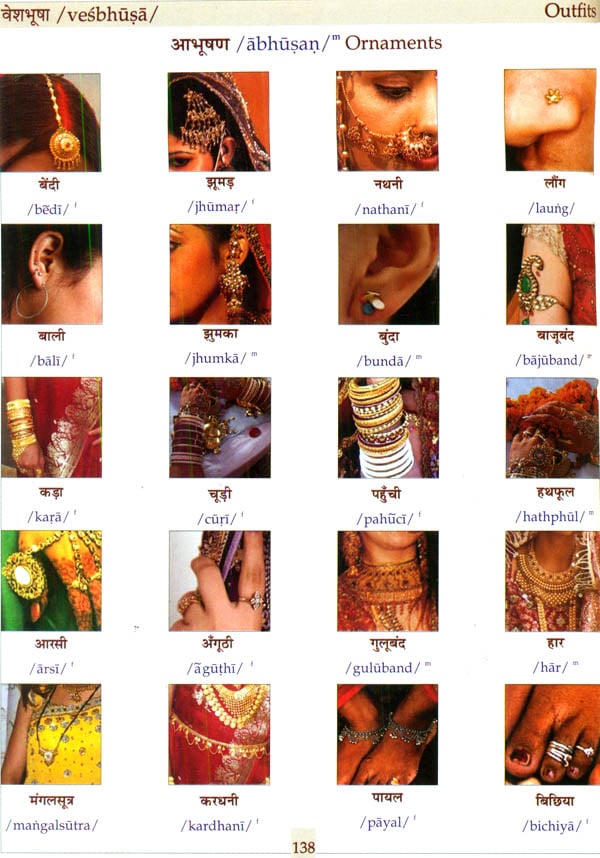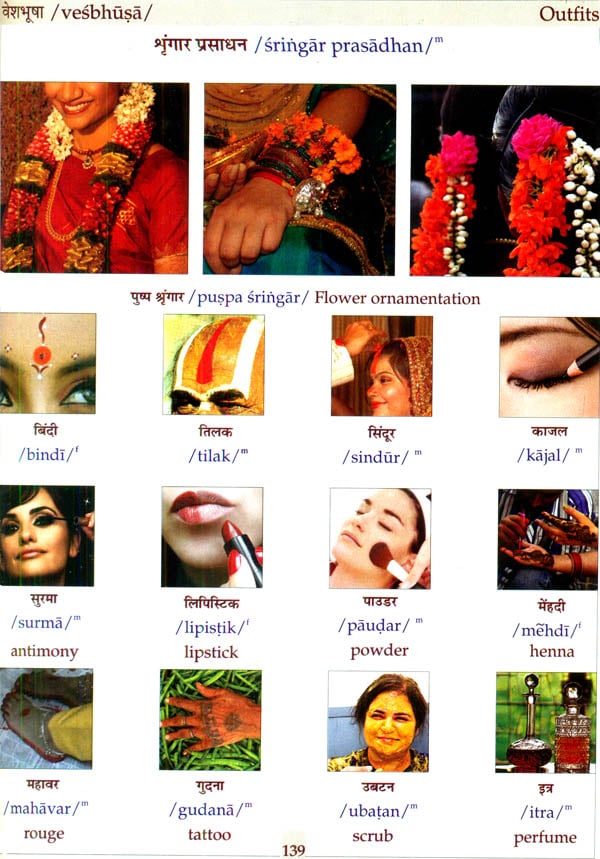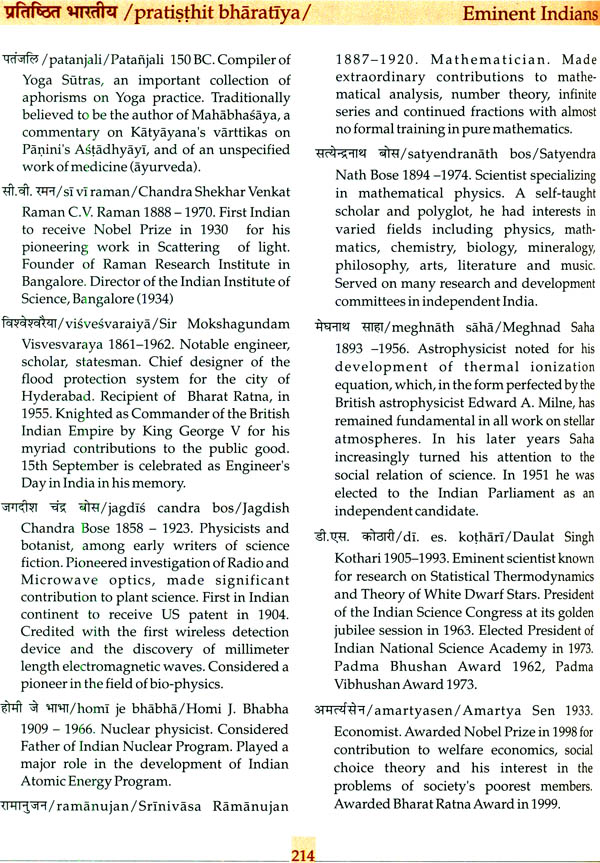
Learner's Hindi-English Thematic Visual Dictionary (Superbly Illustrated)
Book Specification
| Item Code: | NAH054 |
| Author: | Vimlesh Kanti Verma and Sunanda V. Asthana |
| Publisher: | Sasta Sahitya Mandal Prakashan |
| Language: | Hindi Text with Transliteration and English Translation |
| Edition: | 2013 |
| ISBN: | 9788173097812 |
| Pages: | 298 (Throughout Color Illustrations) |
| Cover: | Paperback |
| Other Details | 9.5 inch X 7.0 inch |
| Weight | 860 gm |
Book Description
Hindi is considered as key to understanding India-her people and culture. ‘Learner’s Hindi-English Thematic Visual Dictionary’ is a language-learning tool designed for accelerated language learning. It is aimed at the unique needs of those learners of Hindi at the elementary and intermediate level who know English. The thematic classification and visual illustrations used extensively in this dictionary make language learning easier and more effective. This dictionary is also an active vocabulary builder, which will help students converse in Hindi. This dictionary will help learners in understanding the lexical strength of Hindi and here semantic fineness.
Vimlesh Kanti Verma is a researcher, scholar and teacher of Hindi and Indology for over four decades. He is a senior linguist and has been teaching Hindi Language, Literature and Applied Linguistics to graduate and post-graduate students in India and abroad. His fields of interest are Textual Criticism, Lexicography, Translation Studies and Teaching of Hindi as a foreign language.
Dr. Verma has initiated Hindi Teaching programs at the University of Toronto, University of Sofia and the University of South Pacific. He has conceptualized, designed and implemented several Hindi Language Courses for foreigners. Language teaching aids developed by him are used extensively in India and abroad.
Dr. Vimlesh Kanti Verma has done his M.A. and D.Phil. in Hindi from the University of Allahabad and M.Litt. in Linguistics from Univeristy of Delhi. He is also a Fellow of the Royal Asiatic Society of Great Britain and Ireland (London).
Sunanda V Asthana is a Strategic Communications Specialist and operates globally from Singapore. She leads the Strategic Communications portfolio at ProCube Consultancy- a Strategy Consulting practice. She has worked as a broadcast journalist with leading news channels of India. Sunanda is M.A. in English from Delhi University and holds a P.G. Diploma in Broadcast Journalism from the Indian Institute of Mass Communication, New Delhi.
I was on my first assignment of teaching Hindi as a foreign language at the University of Toronto, Canada in 1973. It was a class of enthusiastic students. They came from all age groups and backgrounds. Curiosity about India brought them to the course.
Artists, scientists and teachers essentially made up my Hindi class at the University of Sofia, Bulgaria. India intrigued them. They said they wanted to understand India-Indian culture, approach, and life. While learning Hindi already gave them a glimpse into India, it essentially empowered them to go out and seek India.
Learning a language is learning a culture. They are inseparable.
I have been teaching Hindi as a foreign language at universities around the world for more than forty years. Each assignment and each student has enriched my understanding of the complex functioning of the language learner, especially those learning a language foreign to them. I felt that the best way to reciprocate to my students is to prepare modern and ever evolving language-learning tools, be they dictionaries, learning kits or phonetics audio kits etc. Some of my students are now reputed teachers of Hindi and Indology and are taking this legacy forward. It gives me satisfaction to see how my body of published work is serving them as a reference point for developing new teaching aids.
The Learner’s Hindi-English Thematic Visual Dictionary, which you hold in your hands, is a text that I have felt the need for throughout years. It has also taken the longest to prepare, as simplifying things is the most complex of tasks.
Language learning is the process of reaching the target language through native language. It is a complex process that requires scientific and pedagogical competence. Language learning tools like bilingual dictionaries provide support in this process. For example, when a Hindi learner whose native language is English, learns the Hindi word “bolna” (to speak), a verb, she/he thinks of the whole range of words in the native language-tell, narrate, explain, request, order, stammer, whisper etc. For the Hindi equivalent of each, she/he needs to look up each word separately in the dictionary a tedious process. A learner should have access to a resource that provides the range of words. I realized that available traditional alphabetical Hindi-English dictionaries, including mine, were limited in this capacity. Thesaurus has a listing of words, but linguistic descriptions required in a pedagogical dictionary are not available. I also felt the need of a text with concise listing and detailing of cultural themes and concepts for effective conversational Hindi. My efforts at finding a text that addressed all these needs for a Hindi learner proved futile. A text was needed to fill the gaps between available learning tools.
I decided to work on a dictionary with a new format, structure and approach. I prepared the outline and structure for this Hindi-English Thematic Visual Dictionary by the Atlantic in Rabat, Morocco, then nurtured it on the foothills of the Jura in France and by the Alster lake in Hamburg, Germany. There were many engaging, exhausting discussions with experts of language teaching, colleagues and students in Delhi, Singapore, Muscat, Johannesburg, Moscow, Mumbai, New York, Port of Spain, Paramaribo, Kathmandu and many more hospitable places. Each question that surfaced made the task challenging yet enriching. After five years of labor, I am now going through the final draft in Bali, Indonesia. On page no. 6 of this dictionary has a painting that symbolizes language learning aptly. The painting shows Ram crossing the bridge built with the help of Nal and Neel, the monkey friends of Hanuman and Sugreev to reach Lanka. To me this dictionary is a bridge too that connects one language with another.
This dictionary is not meant to be exhaustive. Like every research work it has its limitations. Unlike language learning which is a continuous process, work on the final draft has to stop for it to be published. The purpose of this dictionary is to familiarize Hindi learners with the large lexical corpus of Hindi language, semantic range of different similar words and word framing. This book should be seen as an accelerated language-learning tool for English knowing Hindi learners. The words in this dictionary will address the needs of beginner and intermediate level Hindi learners and the pictures will give a visual reference to commonly used terms.
Working in tandem can be a challenge in a geographically dispersed team. Yet I chose to invite Sunanda V. Asthana to work with me on this project. My collaboration with Sunanda goes back to my book “Ganga” which she translated into English in 2001, and to my dictionary “Learner’s Hindi-English Dictionary” in 2006. For this project I needed a partner well versed in Hindi and English; with an understanding of the challenges of foreign language learning; insight into cultural practices, tradition and philosophy of India and with the patience of a Zen master. Sunanda fits the bill perfectly. She happens to be my daughter and I am very proud of her.
I hope this dictionary will create an interest in you to learn and/or teach Hindi.
May your quest for knowledge never seize!
| I. | Introduction | 16-30 |
| II. | Hindi-English Thematic Visual Dictionary (An Active Vocabulary Builder) | |
| A. Classification of the Lexical Corpus | ||
| 1 | Nature | 31-63 |
| 2 | Human Body | 64-70 |
| 3 | Home | 71-90 |
| 4 | Food | 91-100 |
| 5 | Religion | 101-120 |
| 6 | Family | 121-124 |
| 7 | Rites and Rituals | 125-129 |
| 8 | Outfits | 130-142 |
| 9 | Festivals and Fairs | 143-147 |
| 10 | Transport Lexicon | 148-152 |
| 11 | Sports and Games Lexicon | 153-156 |
| 12 | Fine Arts | 157-163 |
| 13 | Occupations Laxicon | 164-173 |
| 14 | Politics Lexicon | 174-178 |
| 15 | Country | 179-191 |
| 16 | Rulers of India | 192-195 |
| 17 | Eminent Indians Lexicon | 195-215 |
| 18 | Language | 216-221 |
| 19 | Numerals | 222-224 |
| 20 | Time Lexicon | 225-228 |
| 21 | Measurements | 229-232 |
| 22 | Shapes Lexicon | 233-235 |
| 23 | Colors Lexicon | 236-238 |
| 24 | Mythology Lexicon | 239-247 |
| 25 | Pairs | 248-258 |
| 26 | Glossary | 259-266 |
| 27 | Acronyms | 267-269 |
| III. | Appendix | 270-297 |

